iCups: Connecting people through the smallest memories
Context and Significance
Long distance communication has been an aspect of human life that technology has tried to overcome, or at least improve through the creation of wireless devices such as phones and smart watches, that allow two individuals regardless of their location to contact each other. Nevertheless, after taking into account these significant advances, we have put upon consideration that one aspect lacking from this communication, is the deeper experience and feeling of true connection with the other person, through more than just speech and visual methods, instead by means of memories.
Such experience has been developed before through products such as “Pillow Talk”, which was created by a UK design shop called Little Riot, in order to ameliorate the hardship of long distance love relationships, by enabling communication through glowing pillows. This product works in such a way that the pillows are internet-enabled, therefore, when one person is sleeping, it glows in response and sends a signal over the internet so the other one can light up as well. (Love, 2013) This process allows couples to virtually feel each other’s presence miles away, and wirelessly connect with one another while they sleep (Kelly, 2011)

It is this concept of virtual presence that has been further explored and developed through the creation of “iCups”; as its significance goes beyond superficial talk, to deeper moment connect with our loved ones. With these interactive cups, two individuals will be able to feel each other’s presence through the simplest of everyday memories such as drinking coffee. This product is intended for an audience that maintains long distance relationships with their relatives, and it gives the special value of making them feel close to each other. For example, if it is the case of a daughter who went to college, and she misses her mother as they used to drink coffee every afternoon together, with iCups, they will be able to feel interconnected and reminded of the memories they had, despite of the distance.
Conception and Design
“Today, design has gone far beyond its simple origins as a craft to develop powerful new ways for people to interact with the world, emphasizing experience, not technology.” This conception of design making developed by jnd.com, has been applied to our product, as it encompasses the digitalization of everyday items, to make them into an interactive experience of feeling a loved ones’ presence through the pleasant moments of drinking coffee during the day. Regarding the prototype itself, many had to be created before finalizing on one. This was due to the fact that elements such as OLED displays and buttons had to be added within the cup so that there existed a response between the products along with the temperature sensor. The original idea was to create a physical mug through which you could drink coffee directly from. Nevertheless, in the end, for practical measures, the product that was created was a 3D printed filament cup holder, in the shape of a mug, that contained within a stainless steel cup that captured heat. The reason why we decided to use a stainless steel cup to contain the liquid, and insert it within our mug holder prototype, was so that the extreme temperatures in the liquid inside could actually be detected by the temperature sensor that would be placed in the bottom part of the cup holder. Another option for the product prototype could’ve been utilizing a different material such as cardboard for the holder. However, we rejected it as it would’ve been too unstable for the wires, display, buttons, and even the cup itself. Also, if it were the case that the holder got wet, it would’ve completely ruined a cardboard or weak filament prototype. 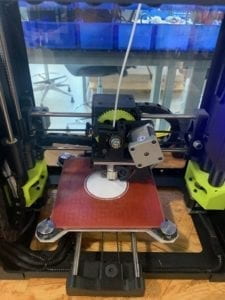
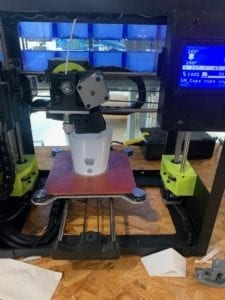
Fabrication and Production
Fabrication and production of the prototype was harder than expected. The most significant steps during the production process I would consider would be: first, grounding the idea to a specific aim; second, developing the code for the program to work how we want it to; and third, creating the prototype based on what best is directed towards our goals for the project. Regarding the physical fabrication, other than taking into consideration the elements that had to be included into the cup, comfort was another aspect that had to be addressed. After the user testing, the prototype production was modified in such a way that the product actually looked like a cup, instead of an object with strange appearance and openings for buttons. As during the user testing, many people who tried using the object, were unsure how to as there was no handle and just a cup with a black screen and wires. Likewise, the fabrication of the code for the interaction to work, was quite a challenge as well. As even though initially both displays worked perfectly independently, when trying to get them to intercommunicate while using delays within the circuit, they started to be faulty. The problems faced ranged from displays not turning on, or mixing up the letters that had to be shown, to them not sensing the input, and outputting the wrong information. In the end, we managed to achieve that both cups interacted with one another somewhat how we wanted them to, as even though they did display text when sensed upon temperature, and the buttons were able to send a response; the system was faulty in that it took too long for both displays to process the information, as the code contained too many delays within it. Regardless of the technical difficulties we had with the adaptations made to the code, in terms of the changes and evolution of the prototype of the cup holder design itself, it did become more successful as it was more comfortable for the users, and gave them a clearer idea of the usage of the product.
Code: https://gist.github.com/arianaalvarezv/8b833c73e479391f045614aec02116b4
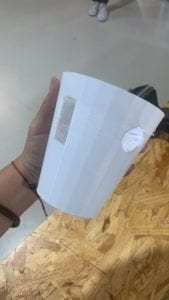 Design 1
Design 1
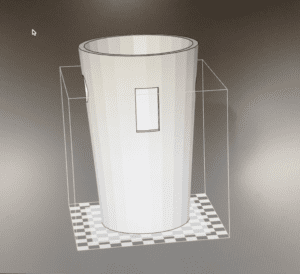 Design 1 3D Modelling
Design 1 3D Modelling
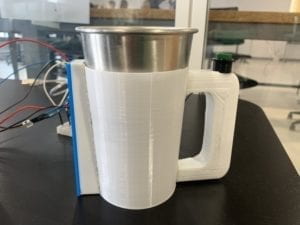 Design 2 Sideview
Design 2 Sideview
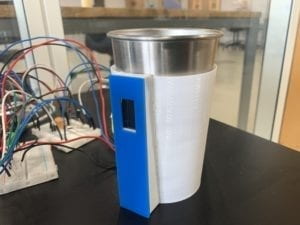 Design 2 Frontview
Design 2 Frontview
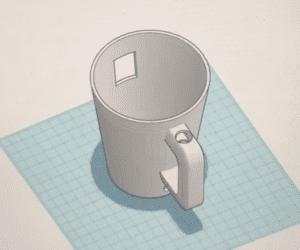 Design 2 Tinkercad 3D Modelling
Design 2 Tinkercad 3D Modelling
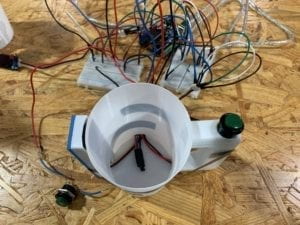 Design 2 Cup Assembled
Design 2 Cup Assembled
Conclusions
After considering the significant advances in communication technology that have been evident in the emergence of cellular phones such as iPhone, which serve the purpose of connecting people with their relatives even if far away in the distance. Our project aligns directly with not only this concept of new communication technology that connects people through memories, but also evidently supports our definition of interaction; as there are responses to every action. Ever since individual1 fills cup 1, which triggers a temperature sensor that sends a message to cup 2, consequently allowing individual2 to know what the other person is doing; that is already interaction between people and digital sensors that activate screens. Furthermore, when individual2, is given the ability to respond back to individual1’s message through the display by pressing a button; that furthers the interaction between both objects as it is a way of assuring that the project effectively works, and aligns with the action/reaction relationship within interactivity.
Based on how the final outcome came to place, our audience interacted in a positive way with the idea of the project, as they agreed on the fascinating concept of a new way of feeling a loved ones’ presence through interaction that goes beyond a video or phone call, instead it is felt and thought of by the participants. Nevertheless, if I had more time I would improve my project in such a way that it expanded the scale of the display, so it was a more pleasant experience for the user. Also, I would research more regarding the code involved, so that there could exist less delays in order for the message to achieve to the other cup faster. As well as, I would attempt to install a 5G program which could make the cups in reality work over the internet and wireless communication. Nevertheless, from the setbacks I have been able to realize the real problems that occur when creating a product, however alongside with these failures come the accomplishments, from which I’ve been able to learn that any idea in mind is possible to achieve by continuing effort, research, and consulting help from experts.
This project for me, meant much more than just creating a prototype from what we learned in class of Arduino. Through the creation of iCups, the real issue that has been wanting to be addressed is the importance of human connection. With this product, my partner and I were attempting not only to join people through the smallest memories, but also to make them realize how it is not the “phone call” or “video call” that matters the most many times, as those are only given once in a while when both parties have time. Instead, the true meaning behind connecting with a person, is feeling its presence, and knowing that despite any distance or time difference, they will always be with you, even if it’s just through a cup of coffee.
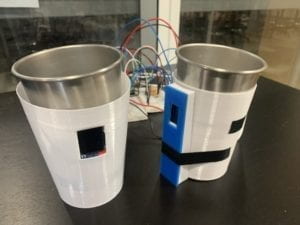 Final Circuit
Final Circuit
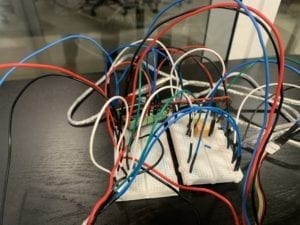
References:
https://www.businessinsider.com/pillow-talk-kickstarter-2013-7
https://www.huffpost.com/entry/long-distance-relationship-pillow_n_1079910
https://jnd.org/the_future_of_design_when_you_come_to_a_fork_in_the_road_take_it/